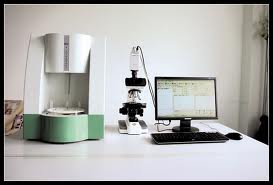Difference between revisions of "Sedimentation Analyzers"
(Created page with "Category:Analyzing{{Knoppen}} <noinclude><!------------------------------------------------ * READ THIS FIRST * Only edit this page if you can improve the content. * Imprope...") |
|||
| (One intermediate revision by one other user not shown) | |||
| Line 1: | Line 1: | ||
[[Category:Analyzing]]{{Knoppen}} | [[Category:Analyzing]]{{Knoppen}} | ||
[[File:Sedimentation Analyzers.jpg|thumb|right|Sedimentation Analyzers]] | |||
'''Sedimentation Analyzer''' can measure the sedimentation velocity distribution, and its data processing program, sedigraph, convert it into a distribution of other sedimentation variables, such as shape-specified grain size. | |||
In Sedimentation Analyzers, Sedimentation particle size measurement technology depends on the sedimentation rate of the particles in the liquid to measure the particle size distribution. As to sedimentation particle size analysis, first of all, the sample and liquid are mixed to make suspending liquid with certain consistency. The particles in the liquid begins to sedimentate due to gravity or centrifugal force, the sedimentation rate depends on the particle dimension, the sedimentation rate of the large particles is fast, and small particles is slow. The particle dimension and particle size distribution are measured according to different sedimentation rate. | |||
But in fact, it is very difficult to measure the sedimentation rate of the particles. So the sedimentation rate is judged indirectly by measuring the variance ratio of suspending liquid consistency of some depth under liquid level, and the particle size distribution is also gotten. | |||
Before large particles falls into the measurement area from liquid level, the consistency of this position is invariable; after large particles falls into the measurement area, the consistency of this position begins to drop, with the measurement process going on, the consistency will drop further, the measurement process is not over until all expected measured particles sedimentate under the measurement area. | |||
==Video== | |||
<youtube>zboWd4UiVLg</youtube> | |||
Latest revision as of 22:46, 25 April 2013
Sedimentation Analyzer can measure the sedimentation velocity distribution, and its data processing program, sedigraph, convert it into a distribution of other sedimentation variables, such as shape-specified grain size.
In Sedimentation Analyzers, Sedimentation particle size measurement technology depends on the sedimentation rate of the particles in the liquid to measure the particle size distribution. As to sedimentation particle size analysis, first of all, the sample and liquid are mixed to make suspending liquid with certain consistency. The particles in the liquid begins to sedimentate due to gravity or centrifugal force, the sedimentation rate depends on the particle dimension, the sedimentation rate of the large particles is fast, and small particles is slow. The particle dimension and particle size distribution are measured according to different sedimentation rate.
But in fact, it is very difficult to measure the sedimentation rate of the particles. So the sedimentation rate is judged indirectly by measuring the variance ratio of suspending liquid consistency of some depth under liquid level, and the particle size distribution is also gotten.
Before large particles falls into the measurement area from liquid level, the consistency of this position is invariable; after large particles falls into the measurement area, the consistency of this position begins to drop, with the measurement process going on, the consistency will drop further, the measurement process is not over until all expected measured particles sedimentate under the measurement area.
Video
